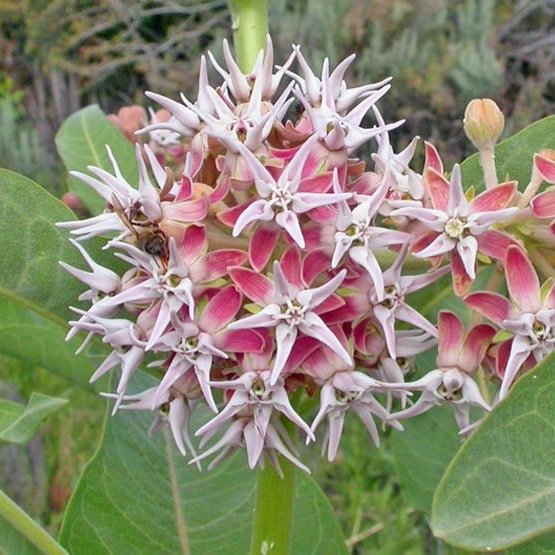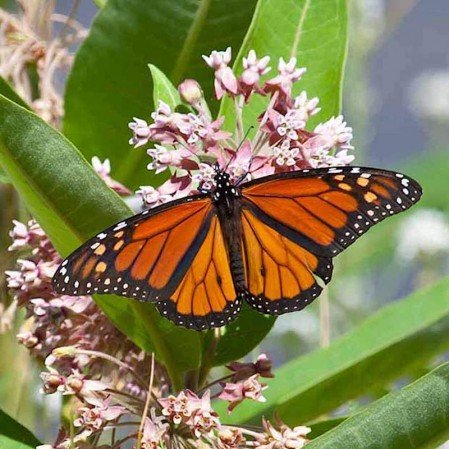Milkweed Finder
Asclepias speciosa
(Showy Milkweed)
Best For: Western U.S.
States: CA, OR, WA, NV, ID, UT, CO, AZ, NM
Conditions: Full sun; well-drained soil; drought-tolerant
Asclepias syriaca
(Common Milkweed)
Best For: Eastern & Central U.S.
States: New York, Pennsylvania, Michigan, Ohio, Illinois, Indiana, Wisconsin, Iowa, Minnesota
Conditions: Full sun, adaptable to a range of soil types
Asclepias incarnata (Swamp Milkweed)
Best For: Eastern, Midwest, & Southern U.S.
States: MI, OH, PA, IL, IN, WI, IA, MO, LA, TX
Conditions: Full sun to partial shade; prefers moist soil; ideal for rain gardens
Monarch butterfly populations have faced a steep decline in 2024, driven by habitat loss, climate-induced weather extremes, and migration disruptions. The situation has prompted urgent conservation efforts, especially across regions critical to breeding and migration, such as the Midwest, Northeast, Texas, and California. Individuals can contribute by planting native milkweed in fall, providing critical support for breeding and migration cycles, while avoiding tropical milkweed and other common planting mistakes to ensure proper support.
Significant Declines in 2024
• Both eastern and western monarch populations experienced dramatic declines—59% for eastern populations and 30% for western populations. These declines have set off alarms among conservationists, highlighting vulnerabilities to extreme weather, drought, and habitat degradation across North America .
2. Primary Drivers of Decline
• Climate factors: Increased drought, extreme heat, and erratic weather patterns disrupt breeding, migration, and nectar availability.
• Habitat loss: Expansion of agriculture, urban development, and herbicide use have reduced milkweed and nectar plants, affecting monarch survival and reproduction .
3. Conservation Focus
• Regions like the Midwest, Texas, and California are pivotal for monarch recovery, offering breeding habitats, migratory corridors, and overwintering sites.
• Collaborative efforts by organizations like WWF and Monarch Joint Venture are vital to restoring habitats, increasing milkweed abundance, and raising awareness .
4. Individual Contributions
• Plant native milkweed in fall: This is a crucial step to help support monarch populations, as it aligns with natural germination cycles and provides essential breeding resources.
• Avoid mistakes like planting tropical milkweed (due to its year-round growth that disrupts migration), mistimed planting, choosing shady spots, or using treated seeds .
5. Straightforward Milkweed Selection
• Most U.S. regions can rely on Common, Showy, or Swamp Milkweed as the primary choices, depending on local climates and soil conditions. These varieties support monarchs across their entire breeding range
Agencies Calling for Monarch Conservation
Several key organizations and agencies are actively calling for efforts to protect and restore monarch butterfly populations:
1. Monarch Joint Venture (MJV)
• MJV collaborates with federal and state agencies, non-governmental organizations, and the private sector to implement conservation plans across North America. They emphasize habitat restoration, planting native milkweed, and addressing climate adaptation to secure the monarch migration.
• MJV leads initiatives like the Monarch Monitoring Blitz, which encourages public participation to gather crucial data on monarch populations .
2. Xerces Society
• Xerces focuses on habitat restoration, promoting sustainable land management, and implementing a “climate lens” in conservation. They have highlighted the urgency of protecting natural habitats and implementing sustainable gardening practices to prevent further declines.
• Xerces advocates for policy changes and increased public and private investment in conservation, stressing that monarchs face extinction without immediate action .
3. National Wildlife Federation (NWF)
• NWF promotes habitat creation through public campaigns and policy support, emphasizing planting native milkweed and nectar plants to aid breeding and migration. They advocate for large-scale restoration projects and public engagement through community science initiatives .
4. U.S. Fish and Wildlife Service (USFWS)
• USFWS is considering whether to list the monarch butterfly under the Endangered Species Act (ESA), with a decision expected by December 2024. The agency recognizes that monarchs are at high risk and require immediate habitat protection to ensure their survival and long-term recovery .
5. Farmers for Monarchs
• This coalition includes farmers, industry partners, and conservation groups working to increase milkweed habitat on farmlands. They emphasize the importance of habitat restoration and collaboration with the agricultural sector to protect the monarch’s migration pathways .
Implications of Monarch Extinction
The extinction of monarch butterflies would have significant ecological, cultural, and economic impacts:
• Ecological: Monarchs are important pollinators, and their decline signals broader environmental health issues, particularly affecting pollinator-dependent crops and ecosystems.
• Cultural: Monarchs hold symbolic and cultural importance, especially in Mexico, where their migration coincides with the Day of the Dead. The loss of this migration would diminish cultural heritage.
• Economic: Reduced pollination could impact agriculture, affecting crops that rely on pollinators, thereby increasing costs and threatening food security .
The combined efforts of these organizations highlight the urgency and broad implications of preserving monarch populations.
Sources:


